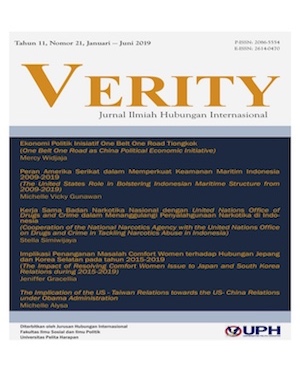EKONOMI POLITIK INISIATIF ONE BELT ONE ROAD TIONGKOK [ONE BELT ONE ROAD AS CHINA'S POLITICAL ECONOMIC INITIATIVE]
DOI:
https://doi.org/10.19166/verity.v11i21.2448Keywords:
Political economy, foreign policy, struggle of power, power projection, hegemonyAbstract
This study analyzes the political motives behind China’s economic policy, known as One Belt One Road (OBOR) Initiative. OBOR offers help to developing country, including Indonesia, to develop their infrastructure and domestic industries. This initiative can enlarge China's political power on the global scene, and pose a greater threat to the United States. To collect data and arguments about China's political and economic position, this study uses an explanative-qualitative method. Neorealism, hegemony stability, regionalism, and political economy are theories that are used to shape the thinking frameworks and to solve the existing problems. China also aims for greater power in the region, to secure the country’s interest. According to neorealism theory, a country's behavior is a manifestation of the country's interests and the only way to secure the country is by becoming a strong state. The stronger the state, the less chance that the country can be attacked. That means, China’s OBOR could also create conflict of interests with other countries.
References
Bretton Woods Project. (2017). What are the Bretton Woods Institutions? Retrieved from http://www.brettonwoodsproject.org/2005/08/art-320747
Cohn, T. H. (2012). Global political economy (6th ed). Boston, MA: Pearson.
Department of State. (1948). Marshal Plan, 1948. Office of the Historian. Retrieved from https://history.state.gov/milestones/1945-1952/marshall-plan.
Dunne, T., Kurki, M., & Smith, S. (2016). International relations theories: Discipline and diversity. Oxford, UK: Oxford University Press. https://doi.org/10.1093/hepl/9780198707561.001.0001
Esterberg, K. G. (2001). Qualitative methods in social research. New York, NY: McGraw-Hill Companies.
Fasslabend, W. (2015). The silk road: A political marketing concept for world dominance. European View, 14(2), 293-302. https://doi.org/10.1007/s12290-015-0381-3
Gilpin, R. (1981). War and change in world politics. New York, NY: Cambridge University Press. https://doi.org/10.1017/CBO9780511664267
Gubrium, J.F . & Holstein, J. A. (1997). The new language of qualitative method. New York, NY: Oxford University Press.
Guluzian, C. (2013). Making inroads: China's new silk road initiative. Cato Journal, 37(1), 135 -148.
Guthrie, D. (2006). China and globalization: The social, economic, and political transformation of Chinese society. New York, NY: Routledge.
Hay, C. (2013). International relations theory and globalization (2nd ed). Oxford, UK: Oxford University Press. Retrieved from http://www.fmprc.gov.cn/mfa_eng/zxxx_662805/t1346238.shtml
Krasner, S. D. (1976). State power and structure of internasional trade. World Politics, 28(3), 317-347. https://doi.org/10.2307/2009974
Kuhn, R. L. (2017). Structuring the Chinese dream. Retrieved from http://usa.chinadaily.com.cn/opinion/2014- 01/25/content_17257856_2.htm.
Li, G. (2016). Interpreting China's diplomatic principles. Beijing, China: Foreign Language Press.
Malo, M. & Sulistiawan. (1986). Metode penelitian sosial, teknik pengumpulan data, Buku Materi Pokok 6. Universitas Terbuka.
Mansbach, R. W. & Rafferty, K. L. (2008). Introduction to global politics. New York, NY: Routledge. https://doi.org/10.4324/9780203946114
Mearsheimer, J. (2001). Tragedy of great power politics. New York, NY: W.W. Norton & Company, Inc.
Ministry of Foreign Affairs of the People's Republic of China (2018). Foreign Minister Wang Yi Meets the Press. Retrieved from https://www.fmprc.gov.cn/mfa_eng/zxxx_662805/t1540928.shtml
Morgenthau, H. (1963). Politics among nations: The struggle for power and peace (7th ed). New York, NY: McGraw-Hill/Irwin.
Nye, J., Keohane, R. O., & Bergsten, C. F. (1975). International economics and international politics: A framework for analysis. Washington, DC: The Brookings Institution.
Peng, Y. (2017, January 20). How Can China Guide Economic Globalization? Retrieved from https://thediplomat.com/2017/01/how-can-china-guide-economic-globalization/
Romano, G. C. & Meglio, J. (2016). China's energy security: A multidimensional perspective, China's new energy haven: Opportunities and challenges in Central Asia. New York, NY: Routledge.
State Council Information Office. (2017). Why is the 'Belt And Road' initiative important?.
Steans, J. (2015). An introduction to international relations theory: Perspectives and themes. London, UK: Routledge.
Sugiono, M. (1999). Kritik Antonio Gramsci terhadap pembangunan dunia ketiga, Yogyakarta, Indonesia: Pustaka Pelajar.
Swaminathan, J.M. (2009). Indian economic superpower: Fiction or future. Singapore: World Scientific Publishing Co. Pte. Ltd. https://doi.org/10.1142/6860
The Economist. (2017). The Asian Development Bank tries to evolve. Retrieved from https://www.economist.com/news/finance-and-economics/21711922-fifty- years-old-and-under-pressure-china-asian-development-bank-tries.
Viotti, P. R., & Kauppi, M. V. (2013). International relations and world politics (5th ed.). Upper Saddle River, NJ: Pearson.
Wallerstein, I. M. (1991). The politics of the world-economy: the states, the movements, and the civilizations. Cambridge,UK: Cambridge University Press.
Waltz, K. (1979). Theory of international politics. New York, NY: McGraw-Hill.
Wang, Y., & Chen, F. (2016). Belt and road initiative: What will China offer the world in its rise. Beijing, China: New World Press.
Yongnian, Z., & Chi, Z. (2018). The Belt and Road Initiative and China’s grand diplomacy. China and the World, 1(3), 1850015. https://doi.org/10.1142/S2591729318500153
Downloads
Published
Issue
Section
License
Authors who publish with this journal agree to the following terms:
1) Authors retain copyright and grant the journal right of first publication with the work simultaneously licensed under a Creative Commons Attribution License (CC-BY-SA 4.0) that allows others to share the work with an acknowledgement of the work's authorship and initial publication in this journal.
2) Authors are able to enter into separate, additional contractual arrangements for the non-exclusive distribution of the journal's published version of the work (e.g., post it to an institutional repository or publish it in a book), with an acknowledgement of its initial publication in this journal.
3) Authors are permitted and encouraged to post their work online (e.g., in institutional repositories or on their website). The final published PDF should be used and bibliographic details that credit the publication in this journal should be included.


